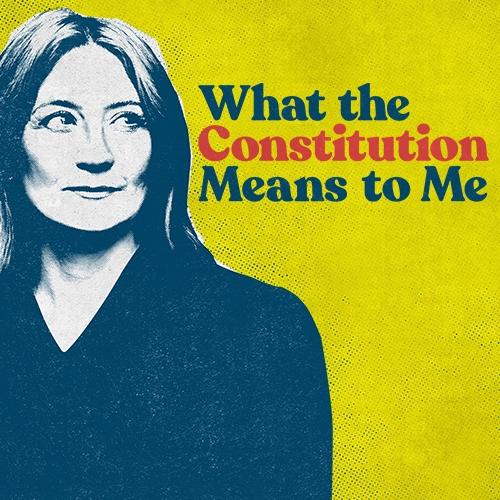
I’m one of those theatergoers that runs away screaming at the idea of “audience participation.” I avoid improv comedy like the plague because I disdain being called upon to provide a suggestion. When attending the theater I like to be out of the line of the sight of actors, as catching the eye of one of the performers could take me out of the storytelling.
Yet I found myself willingly wrapped up in the proceedings of What The Constitution Means To Me. Performers Heidi Schreck, Mike Iveson and (on the night I saw the show) Rosdely Ciprian spend the show directly addressing the audience at Broadway’s Hayes Theater. This recognition into the story of Constitution immerses us so fully and warmly into the proceedings, I willingly felt a part of the ensemble driving the story forward.
I don’t mean to confuse this style of production with “immersive theater,” where the audience is brought into the physical world of the show as is the case with this year’s revival of Rodgers and Hammerstein’s Oklahoma! It’s not even the same as Hadestown where the actors recognize the audience during the performance.
That being said, the proscenium is hardly a confine for the actions of Constitution. Characters enter and exit through the audience and cues are yelled up to the theater’s booth. Without being physically transformed into anything other than the Hayes Theater, the auditorium feels a part of the set in Constitution.
This welcoming of the audience is not a unique theater construct. Earlier this season, Mike Birbiglia winningly included the audience in his performance of The New One at the Cort Theater. Like Constitution, this device never felt off-putting or exhausting. But while Birbiglia simply referenced specific audience members, Schreck includes the audience as a living, breathing force into her performance. She does not so much reference one theatergoer, as she includes us as one solidated entity.
Working together, the audience engages with Schreck throughout the performance to help her tell the story. At times we are asked to audibly cheer or jeer at ideas or statements, not as individuals but as a group. The moments where both happen simultaneously are thrilling as the room feels to vibrate with the power of connectivity.
Several moments in the show included references to current events from the last week. The proceedings in Constitution feel so alive that it’s hard to tell where the script could end. At times its structure feels jolting, but the plot never missteps or feels unintentional.
When I saw the show, the performance ended with Schreck and Ciprian sitting on the edge of the stage to ask each other questions “provided by last night’s audience.” I spent a lot of time in the following days wondering if they were really questions provided by theatergoers or were simply a part of the script. In the end, I decided it didn’t matter because it made me feel something either way. And that’s the kind of experience we go to the theater for.

Broadway’s Legacy Robe: An Ensemble Tradition
Women of Broadway: Friendship at King Kong
Published in collaboration with The Ensemblist
Listen to the Ensemblist Podcast
The Ensemblist: Instagram, Facebook, Twitter


THE ENSEMBLIST IS AN ONLINE ADVOCATE FOR THE TALENTED ARTISTS WHO WORK IN BROADWAY ENSEMBLES. What started as an audio podcast for those curious about how Broadway really works turned into an avenue for young and aspiring professional artists to learn more about theatre from in the inside out. In addition to more than 150 podcast episodes, available on Apple podcasts, Stitcher, TuneIn and Podbean, The Ensemblist’s blog features daily posts from artists about their work and lives. The Ensemblist is also active on both Instagram and Twitter, with more than 10,000 followers on each platform. Through our posts, podcasts and features, we are changing the conversation about what it means to be a successful theatre artist.
Read Full Profile© 2021 TheatreArtLife. All rights reserved.

Thank you so much for reading, but you have now reached your free article limit for this month.
Our contributors are currently writing more articles for you to enjoy.
To keep reading, all you have to do is become a subscriber and then you can read unlimited articles anytime.
Your investment will help us continue to ignite connections across the globe in live entertainment and build this community for industry professionals.